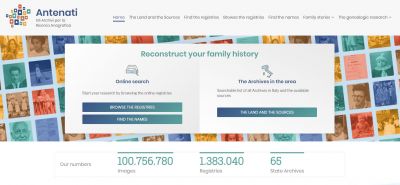Now is the perfect time to begin or continue your Italian genealogy research, specifically within Italy’s Ancestors Portal known as Portale Antenati. This online portal is the best thing to happen to Italian Americans since the steamships that brought our families here! The portal offers free online access to millions of Italian civil records created as early as 1809 and as late as the 1930s with more records added each day. The portal also includes some military records which are more difficult to find elsewhere. It was officially launched in late 2011 with the goal of providing easy access for those researching civil records held in state archives throughout Italy. It currently has over 100 million digitized images covering almost 1.4 million registries from 65 state archives. The website is in Italian and English and when a visitor logs in from America, it automatically presents the pages in English.
How to search the Portal.
http://www.antenati.san.beniculturali.it/?lang=en
If you know the commune and approximate year of the event you are searching, you can easily browse the available registries. Click on “Browse the Registries” located under Online Search and follow these step-by-step instructions:
1. Find the name of your ancestral province, for example L’Aquila.
2. Choose the period of when your ancestor’s record would have been created (Napoleonic 1809-1814; Restaurazione 1815-1860, or Stato Civile after 1861).
3. Select your ancestor’s commune, for example Avezzano.
4. Select the type of record you want to search (Diversi- miscellaneous documents such as deeds, events outside of the commune; Matrimoni – Marriage records; Matrimoni, memorandum notificazioni ed opposizioni – marriage memorandums, notifications and oppositions; Matrimoni processetti –marriage documents such as birth for the bride, groom and death for relatives; Morti -death; Nati – birth; Nati, battesimi – birth/baptism; Nati, battesimi esposti – foundlings birth and baptism; Nati, esposti –foundlings birth).
5. Select the year you want to search. Another link with a number will be displayed. This is the number of images digitized for that commune.
6. Scroll through the images and look for the annual index (usually found at the beginning or the end) in which you can search for your ancestor’ name to find the assigned record number or to verify you have the right year for the event. Having the record number makes it easier to determine where the record will be found in the list of images on your screen. This will save you from having to view each image.
Once you have found your record, you can use the information I provided in previous columns to translate the record.
There is another tool in the portal that is in progress but will be extremely useful when it is completed – “Find the Names.” This search tool enables you to enter a name and see the results for that name in all records. Currently, this tool has a limited number of names in its database as the process to add names takes a tremendous amount of effort. It is, however, worth a try to see what records may pop up for your ancestor’s name.
What if Your Commune’s Records Are Not in the Portal
Digitizing and indexing the records is an ongoing project and more records are being added daily. If your ancestral commune is not online yet, you can check the status of the project by going to “The Land and the Sources” link on the homepage and clicking on the map to find your commune. A pop-up will show you if your commune is finished, in progress for posting, in progress for digitizing, or not available.
If your commune is not yet available on the portal, the records may be available for viewing at a Family History Center or an affiliate library with access to www.FamilySearch.org. Before visiting, you should call the center or library to verify hours of operation as the COVID-19 pandemic has affected operations for many of these sites.



